STEPS TO TAKE IF YOU THINK YOUR ROOF CONTAINS ASBESTOS
In the 1900s asbestos emerged as an essential mineral for the construction, manufacturing, and processing industries. However, with the introduction of regulations because of associated health risks, its use was phased out in the UK in 1985. However, this ban did not address asbestos already present in existing roofs. As such, we discuss asbestos and how to arrange its removal.
WHAT IS ASBESTOS?
Asbestos is a silicate-based mineral characterised by long, thin fibrous crystals. It exists in six types, split into two groups: (1) serpentine asbestos (chrysotile) and (2) amphibole asbestos (amosite, crocidolite, anthophyllite, tremolite and actinolite [1].
USES OF ASBESTOS
An excellent insulator, asbestos has been used in fire blankets, building insulation (walls, roofs, ceiling voids, etc.), pipe insulation, flooring and many other products related to construction [2].
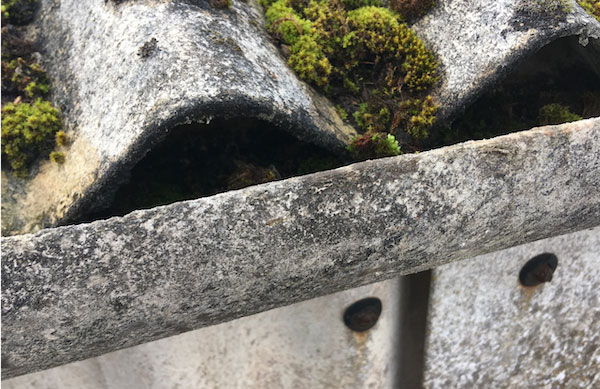
HOW HARMFUL IS ASBESTOS?
All six asbestos types are known to cause serious health hazards in humans. Anisotropic and crocidolite from the amphibole group are the most hazardous, with chrysotile having been used in the majority of products. Diseases linked to asbestos exposure include mesothelioma, lung cancer, ovarian cancer, laryngeal cancer, among others. Smokers have a higher propensity to asbestos-related diseases, presumably due to the combined carcinogenic effect of cigarette smoke [4].
The Hollywood actor Steve McQueen developed mesothelioma, thought to be due to asbestos exposure during his time in the U.S. Marines and heavy smoking [5].
In the UK asbestos licensing regulations were introduced in 1983 with Asbestos (Licensing) Regulations [6] and a final ban in 1999 [7].
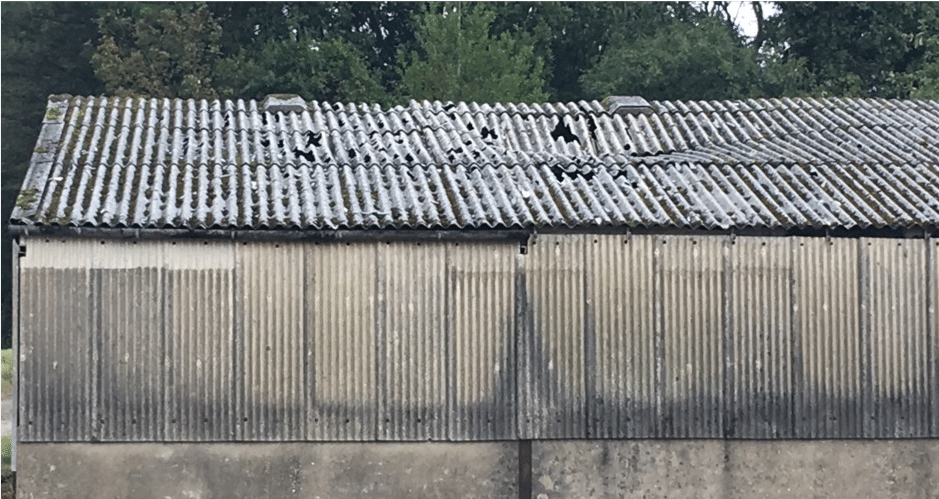
HOW DO I KNOW IF MY ROOF CONTAINS ASBESTOS?
Old leaking asbestos roofs are one of the major risks. Old roofing sheets are fragile and susceptible to breaking apart over time and have the potential to release harmful fibres. Fixings that are corroded and susceptible to lifting and leakage, further weakening the asbestos structure. Flat roof asbestos, like cement and felt-based versions, are still present on many roofs and still in existence, can be identified based on HSE guidelines for asbestos cement. Vermiculite attic insulation is another possible source of asbestos inside the flat roof. If you are in the UK, information about asbestos in your home can and its removal and disposal can be found by searching for your local council’s guidelines on asbestos in your home. The responsibility of commercial asbestos surveys guidelines has also been detailed. This generally applies to the landlord, tenant or managing agent of a commercial property unless a contract states otherwise, according to the HSE. Furthermore, “owners of derelict or vacant premises and warehouses also need an asbestos survey.’

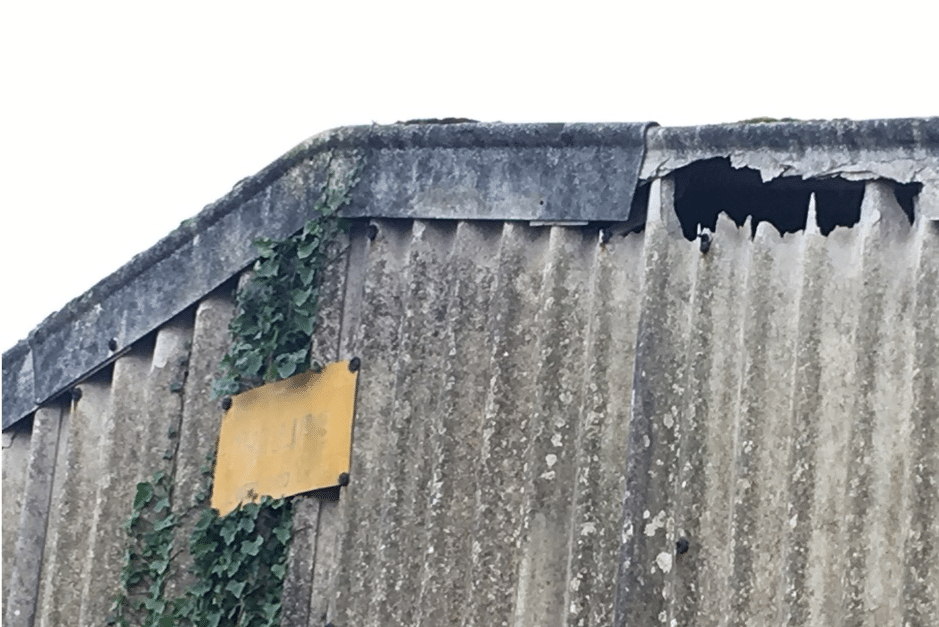
If in doubt, it is best to assume asbestos in your roofing system if the following are true:
- Roofing and insulation on buildings constructed pre-1985
- You weren’t the homeowner before 2000 and the building was constructed pre-2000
What types of roofing materials contain asbestos?
Asbestos can be found in a variety of roofing products and associated materials. These include, but are not limited to roofing felt, roofing insulation, guttering, wall panels and cladding, fascias and soffit panels.
Where else is asbestos found?
Asbestos can also be found in spray coatings, lagging and insulation boards, cement panels, floor tiles and bitumen felt, mastics, sealants, putties and adhesives, textured coatings and paints, yarns, etc. Various guides go into detail about other asbestos locations.
WHAT DO I DO IF I THINK MY ROOF CONTAINS ASBESTOS?
Note: do not under any circumstances attempt to remove or disturb the asbestos roof yourself without specialist advice. If in doubt, isolate the vicinity, seal off areas of ventilation, notify persons localised in that area and place adequate signage at critical entry points, then contact a professional.
We strongly recommended that you contact a qualified roofing specialist or asbestos contractor to assess your roof if you think it might contain asbestos. You can find out guidelines for asbestos removal and disposal according to your local council.
In 1985, amosite (brown asbestos) and crocidolite (blue asbestos) were subject to a UK asbestos ban. However, it wasn’t until 1999 that chrysotile (white asbestos) was banned.
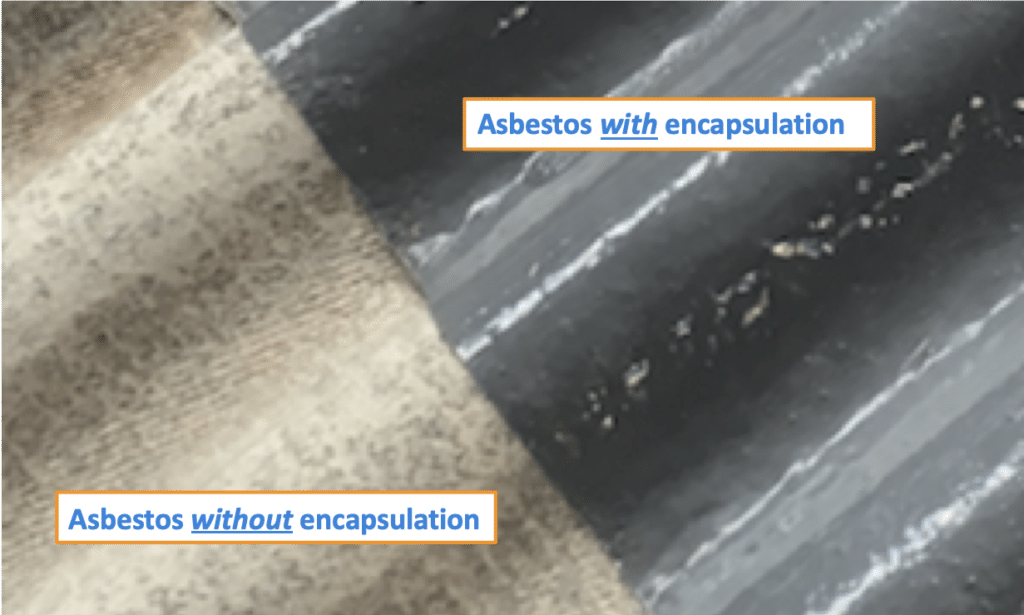
Flat Roof Asbestos
Asbestos was typically used in the flat roofs of garages, sheds, barns, factories, warehouses and offices. Flat roof asbestos typically centres on two main types of asbestos:
- Corrugated cement sheets: these usually contain white asbestos (chrysotile) of which it comprises 10-15% asbestos fibres mixed with cement.
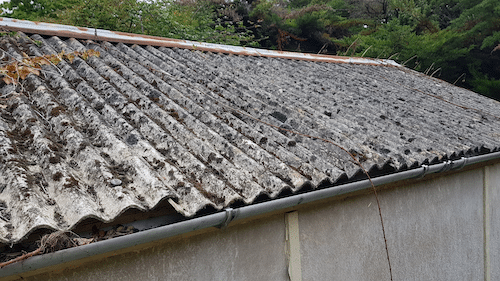
- Cement tiles: similar to above and although on pitched roofs, tiled containing asbestos blended into cement are a common sight on domestic and historic properties.
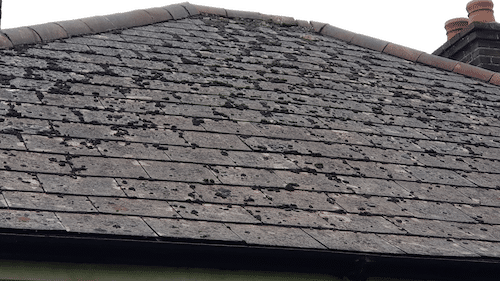
- Asbestos roofing felt: this also contains 10-15% asbestos fibres (the chrysotile type) that have been mixed with asphalt.
Please note that white asbestos was, in the UK, not banned until 1999, so if your building or the flat roof was installed pre-1999, it could be at risk.
The insulation inside the flat roof may also contain asbestos.
HOW SHOULD I CHOOSE AN ASBESTOS ROOFING SPECIALIST?
At first glance
We recommend you look for or request the following information:
- Adequate training in asbestos awareness
- Comprehensive environmental, health and safety policy
- Track record of dealing with asbestos safely and effectively
- Staff with experience in asbestos removal
- Accreditations demonstrating compliance with Health & Safety standards
On-site / on your premises
Based on The Control of Asbestos Regulations 2012, we recommend the following steps to be performed by the contractor:
- Site inspection to assess the condition and type of roofing (flat roof or pitched roof) and any associated insulation
- Checking whether there’s asbestos on your premises, the amount and the condition.
- Preparing and implementing a plan for material risk management.
- Reviewing and monitoring the plan.
- Presuming materials contain asbestos unless there’s evidence it doesn’t.
- Providing information on the location and condition of the material to relevant parties.
- Full risk assessment and COSHH documentation
- Checking whether there’s asbestos on your premises, the amount and the condition.
- Personal protective equipment: FFP3-grade asbestos respiratory masks, overalls, eye masks, gloves. Please note that shortages in these masks are likely given the current Coronavirus (COVID-19) outbreak.
How is asbestos disposed of?
According to the UK Health and Safety Regulations, Asbestos waste is ‘Special Waste’ when it contains more than 0.1 % asbestos [8]. Therefore any materials thought to contain equal to or above this amount should be assumed to contain asbestos. A list of other asbestos regulations is available.
General procedures detailing asbestos waste disposal are:
- Approved waste disposal contractor
- Use of a lockable and sealable waste skip/container
- Confirmed disposed of in hazardous waste and landfill sites.
ASBESTOS TESTING KITS
It is possible to sample roofing asbestos (or any other suspected source) yourself using an asbestos testing kit. this kit should include testing at a UKAS-certified laboratory.
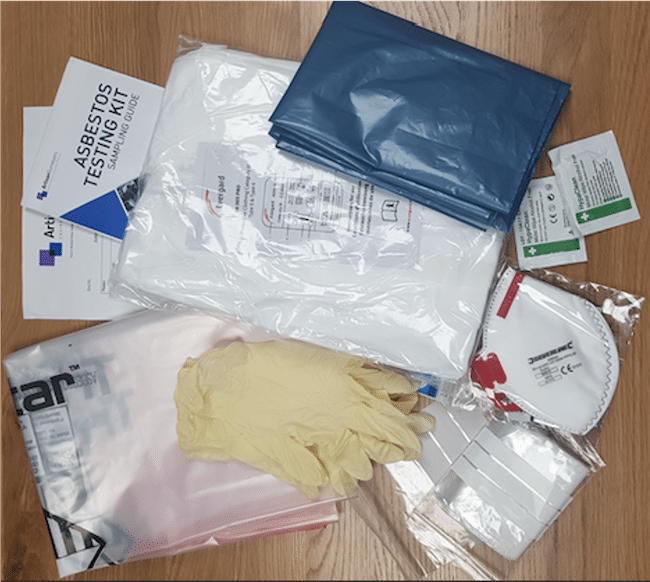
Typically, most asbestos testing kits will include:
- RPE (Respiratory Protective Equipment): flat-valved FFP3 respirator. Please note that due to COVID19, these masks may be of limited availability.
- Everguard type 5/6 coverall
- Gloves
- Waste bags
- Cleaning wipes
- Instructions on how to sample
- Sampling form
Suspected samples should be taken based on HSE recommendations in Asbestos: The analysts’ guide for sampling, analysis and clearance procedures (HSG 248).
Once the asbestos has been sampled, overalls, gloves, respirators and any other materials that may have been in contact with asbestos should be disposed of.
Note: do not take samples of loose insulation, sprayed insulation or lagging that you suspect contains asbestos. This type of asbestos is considered “friable”, meaning that it is easily crumbled by hand; the fibres can be released into the air and can therefore easily enter human airways. The UK HSE provides detail on where to find loose asbestos, what it looks like and how hazardous it is.
Benefits of choosing an asbestos testing kit
- UKAS (United Kingdom Accredited Service) asbestos testing kit
- Fast turn-around times – usually within 24 hours
- Multiple samples – ideal for testing several materials
- Online or by-phone technical support from qualified asbestos professionals
- Accurate, easy to interpret results: positive or negative
What type of results do I get from an asbestos test?
Each sample submitted will receive a UKAS-certified positive or negative result. This will assist you in determining whether you have asbestos in your roof or adjacent materials. The results certificate does not indicate the type of asbestos material (for instance whether it is cementitious or felt-based asbestos).
What should I do if it is not safe to sample asbestos?
If you are not comfortable with sampling asbestos yourself, or have inaccessible or loose asbestos, we recommend you arrange an asbestos survey with a trained and accredited specialist.
ASBESTOS SURVEYS
Regulations and laws govern the control of asbestos-related materials in the UK, US and beyond. The Control of Asbestos Regulations 2012 outline requirements for the UK, whilst the Regulations on Asbestos in the United States are outlined by the Environmental Protection Agency.
One of the first steps you should perform, if you suspect asbestos in your roof or any other part of your property is to arrange a survey.
What Types of Asbestos Surveys are there?
There are several types of asbestos survey applicable to buildings and sections such as roofs, walls, insulation and floors in the UK:
Asbestos Management Surveys
These types of surveys are non-intrusive and can be performed inside buildings with normal occupancy. Materials suspected of asbestos are noted and assumed to have asbestos until proven otherwise. Inaccessible places are also assumed to have asbestos until ruled out by testing. The purpose is to use any information obtained to create an Asbestos Management Plan.
Major Refurbishment and Demolition Asbestos Surveys
- Refurbishment Asbestos Surveys: an asbestos survey of the building is performed to identify asbestos-containing materials (ACMs). Suspected samples are sent for laboratory testing to confirm or rule out asbestos presence.
- Demolition Asbestos Surveys: this survey is performed to identify asbestos presence prior to the demolition of a building, as a means of preventing unnecessary asbestos particulates in the atmosphere.
Re-inspection Asbestos Surveys
These are surveys performed in buildings that already have an asbestos register. Note that if your property was built prior to 2000, it should already be part of an asbestos register. The purpose is to re-evaluate the condition of asbestos that has been identified in previous inspections. This type of survey should be performed annually to monitor any changes in asbestos condition and level of disturbance.
Is an asbestos survey required by law?
In most cases, yes and occupancy without one could be in breach of the law. In short, you should arrange an asbestos survey if your structure or building was built prior to 2000 in the UK. More detailed guidelines by the HSE for The Control of Asbestos Regulations 2012 can be found for non-domestic buildings, construction work and public areas of domestic buildings. For other countries, asbestos may still be in use – please check with a local surveyor.
Who can carry out an asbestos survey?
The UK Health & Safety Executive recommends a detailed overview of the selection of a UKAS accredited asbestos surveyor. However, the AIC recommends contacting experienced builders if they could recommend a competent asbestos surveyor or even existing contacts who have had similar work performed. It is advisable that you select based on previously demonstrated work – look for larger projects and case studies. If possible, seek surveyors who can provide full references from other customers or companies. Cost is another factor – do not select a low-budget option – if it seems too cheap, it probably is. Asbestos is dangerous – health should be the number one priority. In the UK, the United Kingdom Accreditation Service assists in providing accredited organisations in asbestos work.
Whilst these guidelines are targeted at the United Kingdom, they are also highly relevant for the United States, Canada, Europe Asian and beyond.
The UK HSE recommends the following asbestos management guidelines when considering whether a licensed contractor is required. If at any point you are unsure, it is advisable that you use a licensed contractor. Likewise, the United States EPA provides recommendations on hiring asbestos professionals in the US.
THINKING OF REMOVING AND REPLACING ASBESTOS FROM YOUR ROOF OR FLAT ROOF?
If you think your roof or insulation contains asbestos, we recommend you contact a specialist to arrange a site visit.
With over 40 years of experience in roofing, Strandek® GRP Systems are able to help arrange site surveys to facilitate the safe removal of asbestos materials from your roof. Once done, we are able to install asbestos-free insulation and roofing installation. Alternatively, you could install a replacement flat roof yourself using our fibreglass flat roofing kits.
Contact us today on 01633 250652 to speak to a technical specialist. Alternatively, email us.
FREQUENTLY ASKED QUESTIONS (FAQS)
Q. Should I maintain or remove corrugated asbestos or fibre cement roofing sheets?
A. Corrugated asbestos cement roofing sheets are widely seen across many buildings in the UK. In most cases, they should be removed if showing signs of damage to avoid any exposure as soon as possible. This can be accelerated if risk factors like visible damage, close proximity to public or high population areas, near schools or hospitals. In such instances, removal is recommended.
Q. Where can I find out more information about friable asbestos?
A. The UK HSE website displays pictures and links to address and deal with loose-fill asbestos [9].
Q. Does the UK HSE have a document on how to sample asbestos?
A. Yes, this is titled ‘Asbestos: The analysts’ guide for sampling analysis and clearance problems’ [10].
Q. What should I do if I suspect my roof is damaged or in poor condition?
A. If you suspect the roof has been damaged or has shown signs of weakness, it is advisable to contact an asbestos professional. In such instances, roof scaffolding may be required to ensure safe access.
REFERENCES
[1] https://www.asbestos.com/asbestos/
[2] http://www.hse.gov.uk/asbestos/building.htm
[3] www.hse.gov.uk/asbestos/assets/docs/exposure.pdf
[4] http://www.hse.gov.uk/research/rrpdf/rr833.pdf
[6] https://www.legislation.gov.uk/uksi/1983/1649/contents/made
[7] http://www.coshh-essentials.org.uk/assets/live/indg289.pdf
[8] www.hse.gov.uk/pubns/guidance/em9.pdf
[9] https://www.hse.gov.uk/asbestos/essentials/loosefill.htm
